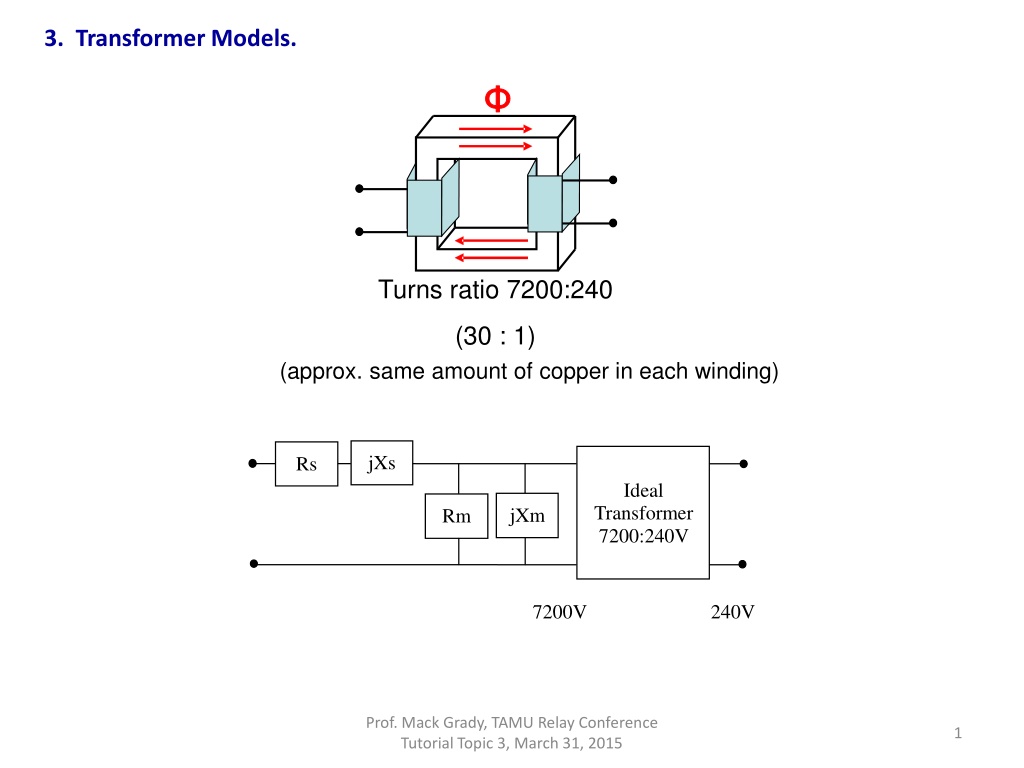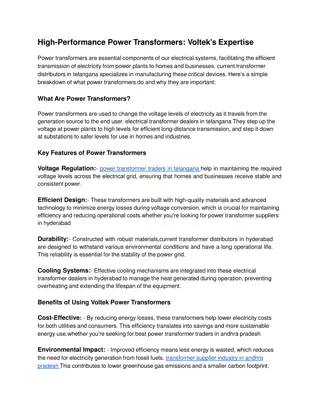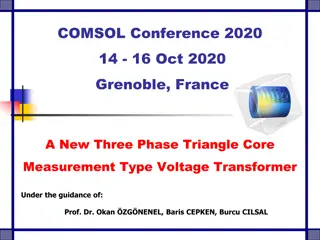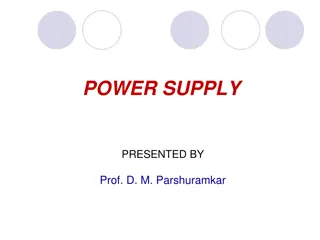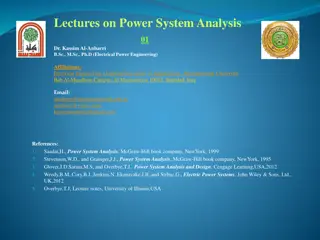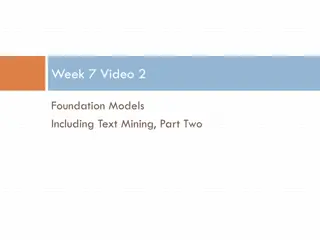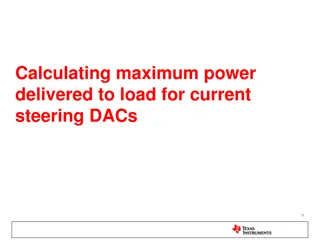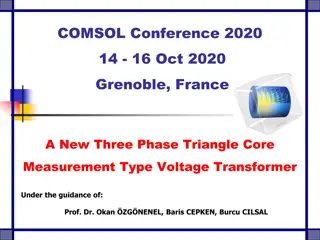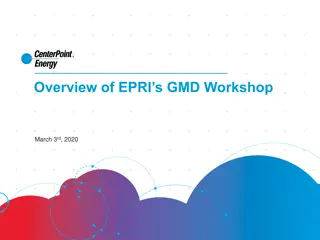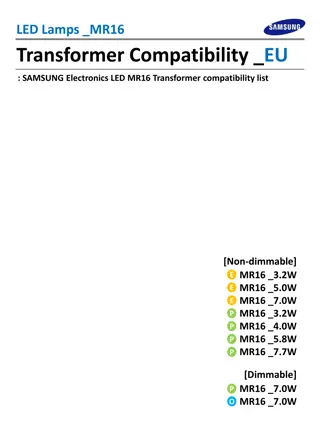Understanding Transformer Models and Tests in Power Systems
In this detailed information, concepts related to transformer models and tests in power systems are covered. Topics include turns ratio, open circuit test, short circuit test, X/R ratios for three-phase transformers, and more. Additionally, it discusses standard percentage values for a 125kVA transformer, load losses, and EPRI studies on distribution feeder losses.
Download Presentation

Please find below an Image/Link to download the presentation.
The content on the website is provided AS IS for your information and personal use only. It may not be sold, licensed, or shared on other websites without obtaining consent from the author. Download presentation by click this link. If you encounter any issues during the download, it is possible that the publisher has removed the file from their server.
E N D
Presentation Transcript
3. Transformer Models. Turns ratio 7200:240 (30 : 1) (approx. same amount of copper in each winding) jXs Rs Ideal Transformer 7200:240V jXm Rm 7200V 240V Prof. Mack Grady, TAMU Relay Conference Tutorial Topic 3, March 31, 2015 1
3. Transformer Models, cont. Open Circuit Test Ioc jXs Rs + Ideal Transformer 7200:240V Voc - jXm Rm 7200V 240V Open circuit test: Open circuit the 7200V-side, and apply 240V to the 240V-side. The winding currents are small, so the series terms are negligible. ~ || = = V ~ oc R jX Turns ratio 7200:240 m m I oc Prof. Mack Grady, TAMU Relay Conference Tutorial, Topic 3, March 31, 2015 2
3. Transformer Models, cont. Short Circuit Test Isc jXs Rs + Ideal Vsc - Transformer 7200:240V jXm Rm Short circuit test: Short circuit the 240V-side, and raise the 7200V-side voltage to a few percent of 7200, until rated current flows. There is almost no core flux so the magnetizing terms are negligible. V jX R ~ = = + + 7200V 240V ~ sc s s I Turns ratio 7200:240 sc Prof. Mack Grady, TAMU Relay Conference Tutorial, Topic 3, March 31, 2015 3
3. Transformer Models, cont. X / R Ratios for Three-Phase Transformers 345kV to 138kV, X/R = 10 Substation transformers (e.g., 138kV to 25kV or 12.5kV, X/R = 2, X = 12% 25kV or 12.5kV to 480V, X/R = 1, X = 5% 480V class, X/R = 0.1, X = 1.5% to 4.5% jXs Rs Ideal Transformer jXm Rm Prof. Mack Grady, TAMU Relay Conference Tutorial, Topic 3, March 31, 2015 4
3. Transformer Models, cont. 1. Given the standard percentage values below for a 125kVA transformer, determine the R s and X s in the diagram, in . 2. If the R s and X s are moved to the 240V side, compute the new values. 3. If standard open circuit and short circuit tests are performed on this transformer, what will be the P s and Q s (Watts and VArs) measured in those tests? Load loss Single Phase Transformer. Percent values on transformer base. Xs No-load loss Magnetizing current Winding 1 kV = 7.2, kVA = 125 jXs Rs Winding 2 kV = 0.24, kVA = 125 Ideal Transformer jXm Rm %Imag = 0.5 7200:240V %Load loss = 0.9 %No-load loss = 0.2 7200V 240V %Xs = 2.2 Prof. Mack Grady, TAMU Relay Conference Tutorial, Topic 3, March 31, 2015 5
3. Transformer Models, cont. EPRI Study, Distribution Feeder Loss Example Annual energy loss = 2.40% Largest component is transformer no-load loss (45% of the 2.40%) Secondary Lines 21% Transformer No- Load 45% Annual Feeder Loss Components Primary Lines 26% TransformerLoad 8% Modern Distribution Transformer: Load loss at rated load (I2R in conductors) = 0.75% of rated transformer kW. No load loss at rated voltage (magnetizing, core steel) = 0.2% of rated transformer kW. Magnetizing current = 0.5% of rated transformer amperes 6
3. Transformer Models, cont. A three-phase transformer can be three separate single-phase transformers, or one large transformer with three sets of windings Wye-Equivalent One-Line Model jXs Rs A Ideal N1:N2 Transformer N1 : N2 jXm Rm N N1:N2 Reflect to side 2 using individual transformer turns ratio N1:N2 Standard 345/138kV autotransformers, GY-GY , have a tertiary 12.5kV winding to permit circulating 3rd harmonic current N1:N2 Y - Y Prof. Mack Grady, TAMU Relay Conference Tutorial, Topic 3, March 31, 2015 7
3. Transformer Models, cont. For Modeling a Delta-Delta Connection, Convert the Transformer to Equivalent Wye-Wye Wye-Equivalent One-Line Model jXs Rs A Ideal 3 3 Transformer 1 N N1:N2 Rm jXm 2 N 3 3 : 3 3 N Convert side 1 impedances from delta to equivalent wye N1:N2 Then reflect to side 2 using individual transformer turns ratio N1:N2 N1:N2 - Prof. Mack Grady, TAMU Relay Conference Tutorial, Topic 3, March 31, 2015 8
3. Transformer Models, cont. For Modeling a Delta-Wye Connection, Convert the Transformer to Equivalent Wye-Wye Wye-Equivalent One-Line Model Rs jXs A Ideal 3 3 Transformer 1 N N1:N2 Rm jXm 3 3 : 2 N 3 N N1:N2 Convert side 1 impedances from delta to wye Then reflect to side 2 using three-phase line-to-line turns ratio 2 3 : 1 N N Has 30 degree phase shift due to line-to-neutral to line-to-line relationship. ANSI standard requires the transformer to be labeled such that high-voltage side leads the low-voltage side by 30 . N1:N2 - Y Prof. Mack Grady, TAMU Relay Conference Tutorial, Topic 3, March 31, 2015 9
3. Transformer Models, cont. For Modeling a Wye-Delta Connection, Convert the Transformer to Equivalent Wye-Wye Wye-Equivalent One-Line Model Rs jXs A Ideal N1:N2 Transformer jXm Rm 2 N 1 : N 3 N Reflect to side 2 using three-phase bank line-to-line turns ratio 2 : 1 3 N N N1:N2 Has 30 degree phase shift due to line-to-neutral to line-to-line relationship. ANSI standard requires the transformer to be labeled such that high-voltage side leads the low-voltage side by 30 N1:N2 Y - Thus, for all configurations, equivalent wye-wye transformer ohms can be reflected from one side to the other using the three-phase bank line-to-line turns ratio Prof. Mack Grady, TAMU Relay Conference Tutorial, Topic 3, March 31, 2015 10
